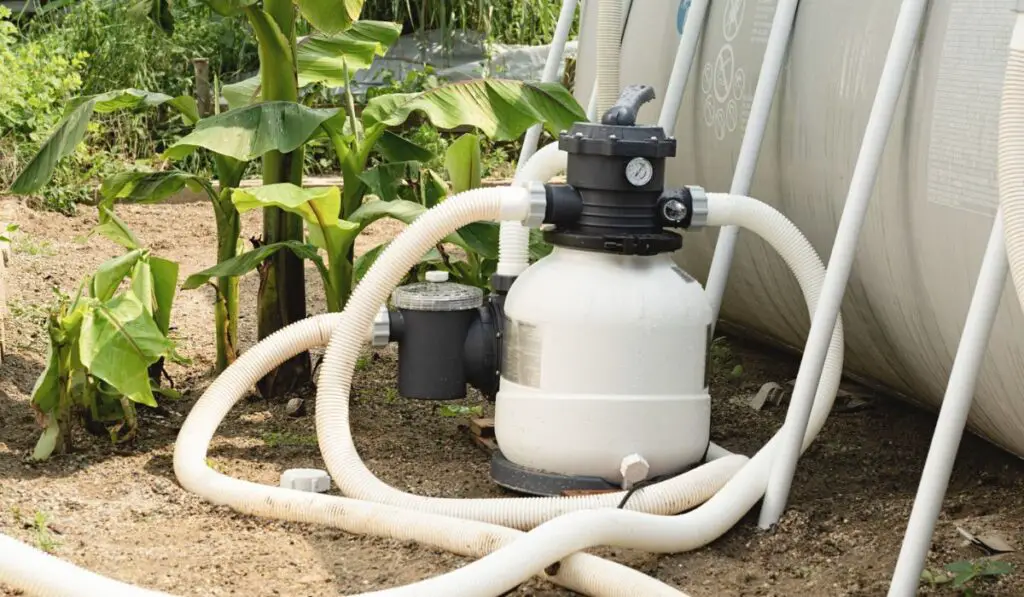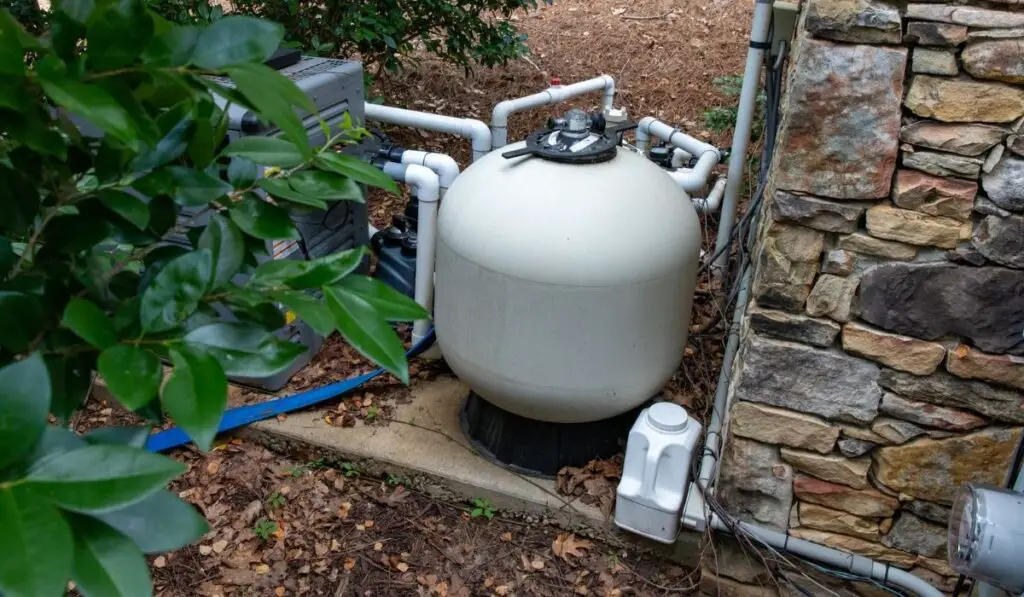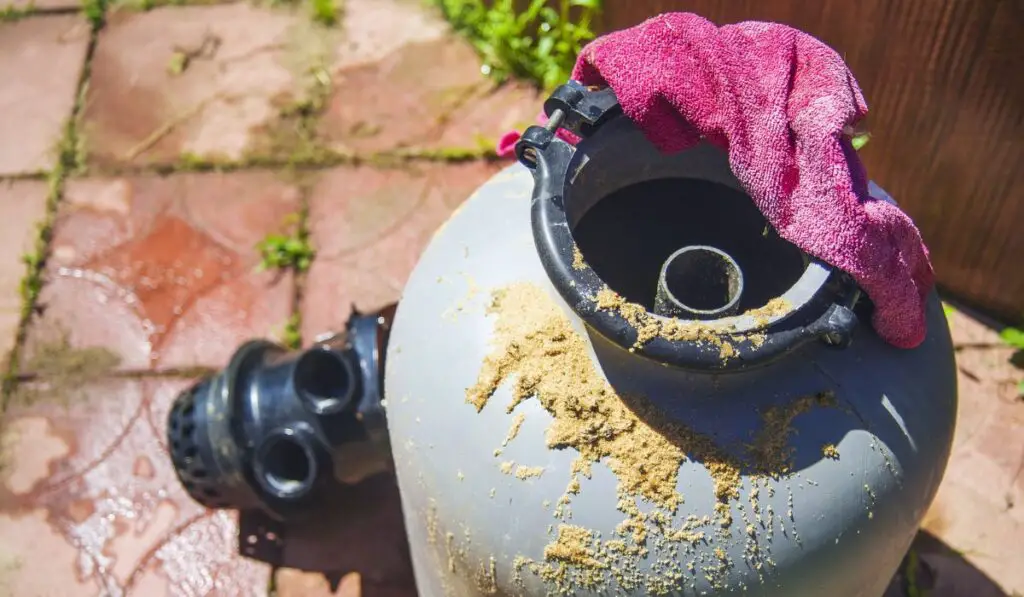Sand pool filters are a great way to keep your pool clean. But these filters can also get a bit complicated to clean–is it possible to clean them on your own without hiring a professional?
Change the sand in a pool filter by turning it off, draining the filter, and locating the multiport valve. Then, remove any hoses you see and gently vacuum out the sand. It can be a bit difficult to do this on your own with fixed PVC pipe sand filters, so you may need the help of a professional.
Knowing how to change the sand in a pool filter can help you to ensure that your swimming pool continues to work properly for years to come. Let’s look at the steps you should take to change out the sand in your pool’s filter.
How Often Should You Change the Sand in Your Pool Filter?

A sand pool filter is a great addition to your swimming pool since it is designed to keep various bugs and other contaminants out of the water. Even though it is deemed the best type of filter, the sand eventually begins to be less effective over time.
In most cases, it is recommended that you change out the sand in your pool’s filter about every three to five years. Over time, while the sand gets better at its job, eventually, there is a time that this stops being the case, and the sand begins to break down.
When the sand breaks down, it will stop being as effective to filter out various contaminants that can make your pool dirty and less safe. You can generally notice when this is the case, as you will see small bits of debris floating in your pool from time to time.
What Are the Different Types of Sand?
When it comes to having a sand pool filter attached to your swimming pool, you should keep in mind that it requires specific types of sand to make it work effectively. There are many different types of sand on the market, and it is important to make sure you are using the right type for your pool filter.
Wondering what the different types of sand are and which ones are best for your filter? Keep reading to find out.
Glass Sand
For pool owners who want to also be kind to the environment, you may want to consider using glass sand(on Amazon) in your pool filter. This is because this type of sand is made from recycled glass but is much better for the environment than sand made from silica.
Because the glass is ground to a fine layer, the risk of cutting you is minimal since the sand is smooth and easy to handle. Additionally, it is much better for your filter because it is not as dense as other types of sand.
Silica Sand
Silica sand(on Amazon) is one of the most commonly used types of sand in sand filters. Silica sand is created from quartz, then ground down to a fine powder easy to incorporate into a filter.
For most pool owners, silica sand is the best choice for their pool filter since it is one of the most inexpensive types. Additionally, silica sand is just as effective at keeping the various contaminants out of your swimming pool as other types of sand.
Zeolite Sand
Zeolite sand(on Amazon) is a great choice for those who want their pool filter sand to do a little more than keep contaminants out of their pool water. Zeolite sand is created naturally from volcanic rock and works slightly better than other types of sand filters.
The zeolite minerals in this sand have a honeycomb shape that makes them much larger and better able to keep debris out of your water. Another advantage of this type of zeolite sand is that it helps to trap chloramines that can wreak havoc on your pool water.
What Happens if You Don’t Change the Sand in Your Filter?

It is important to keep in mind that changing the sand in your pool’s filter is just as important to the maintenance of your pool as your normal cleaning routine. This is because if you do not change it out from time to time, the pool can become contaminated with various debris and contaminants.
If you do not change the sand in your filter every three to five years, you will find that the filter will not work properly to clean your pool. This means that you may notice that your pool looks a bit cloudy, or you will have to shock it more often than usual.
Like most other sand, such as ocean sand, constant exposure to various contaminants can cause the sand to deteriorate over time. This means that it will not have the edges that it typically does that act to keep the debris out of your pool’s water.
Can I Just Backwash My Filter Instead?
Most people know that backwashing the filter is an important part of a regular maintenance routine for your swimming pool. Doing so can keep your filter running properly since it cleans the debris out of the sand.
If you notice that the water in your pool has become somewhat cloudy, there are several reasons this could be the case, including the chemistry being off or the filter not working properly. A filter backwash and chemical rebalancing might be a good idea to see if this is the culprit.
Over time, however, cleaning the filter itself and backwashing the filter may not work to keep it working as well as it should. This is because the sand in the filter loses its edges and begins to work less effectively.
If you have already backwashed your filter and the water is still cloudy, it may be time to change the sand or plan to shock your pool.
How to Change Pool Filter Sand
Once three to five years have passed on the sand in your pool filter, you may begin noticing a cloudiness in your pool water that cannot be fixed with backwashing. If this occurs, you will likely need to change out the sand in the filter to bring it back to proper working order.
After doing your research on the types of sand, you should be ready to choose the one that will work best for you. Once you have chosen, you can follow the steps below to ensure that this complex process is done correctly.
Step 1: Turn the Pump Off
Before you begin to do anything with the pool filter, you will need to turn the pump off of the swimming pool. This can be done by locating the switch, which should be next to the pump or filter then turning the power off.
Be sure to turn any timer you may have previously set from the pump to prevent it from automatically turning on during the cleaning process.
Step 2: Drain the Filter Thoroughly
After you have turned the pump off, you will need to drain the filter tank completely before moving to the next step. This can be done by removing the drain plug and then allowing it time to completely drain all of the water.
Step 3: Take the Collar Off of the Multiport Valve
Either referred to as a collar or a clamp, you should know that this is part of the unit that keeps the multiport valve in place at all times. To remove this, you will need a screwdriver to take out the screws and then gently remove the color from the valve.
Step 4: Remove Pipes and the Multiport Valve
The next step in the process of changing the sand in a pool filter is to remove the pipes or hoses from your multiport valve. While hoses are simple to remove, you may be faced with PVC pipes that have been permanently attached.
If you discover the hard-plumbed PVC pipes on your multiport valve, you will need to cut them out to continue with the process. Once this is done, you will need to gently twist the valve to remove it completely.

Step 5: Cover the Sandpipe and Remove the Sand
When you remove the multiport valve, you will then notice that there is an open sandpipe in the mechanism. Before you remove the sand, you will need to cover this pipe with duct tape, so the sand does not fall into this area.
After you have carefully covered the sandpipe, you will need to use a shop vac to vacuum out the tank. Keep in mind that you will need to be careful as you do so to prevent any damage to the tank itself.
Step 6: Clean the Tank
After all of the sand is removed, you will need to use a hose to clean out the tank carefully to ensure that no debris is left behind. Allow time for the tank to dry before moving on to the next step in the process.
Step 7: Add New Sand and Water
Before you add your new sand to the tank, you should first replace the drain plug to ensure the sand does not just drain back out. You will need to ensure that the plug is sealed properly at this point.
You can now add your sand of choice directly into the tank since you have the sandpipe covered properly. Once the correct amount of sand has been added, you will then need to fill the tank the rest of the way with water.
Step 8: Reattach the Multiport Valve
One of the last steps in the process is to reattach the multiport valve to your tank by following a few simple steps. Failure to do so can result in the pool filter not functioning properly when you turn the pump back on.
The first thing you will need to do is apply a lubricant to the O-ring to ensure that it attaches properly to the tank. At this point, you can reattach the multiport valve to the tank and ensure that it has been sealed properly.
Step 9: Reattach the Pipes and Collar
As a final step, you will need to reattach or replace the pipes you took off of the multiport valve at the beginning of the process. Once they are in place, you can replace the collar to the valve and then turn the pump back on.
